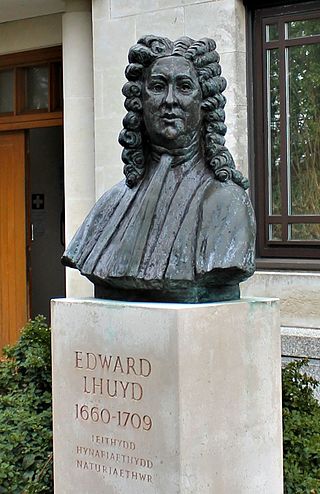Related Research Articles

An antiquarian or antiquary is an aficionado or student of antiquities or things of the past. More specifically, the term is used for those who study history with particular attention to ancient artefacts, archaeological and historic sites, or historic archives and manuscripts. The essence of antiquarianism is a focus on the empirical evidence of the past, and is perhaps best encapsulated in the motto adopted by the 18th-century antiquary Sir Richard Colt Hoare, "We speak from facts, not theory."
William Wotton was an English theologian, classical scholar and linguist. He is chiefly remembered for his remarkable abilities in learning languages and for his involvement in the Quarrel of the Ancients and the Moderns. In Wales he is remembered as the collector and first translator of the ancient Welsh laws.
This article contains information about the literary events and publications of 1708.

Antoine Houdar de la Motte was a French author.

Edward Lhuyd, also known as Edward Lhwyd and by other spellings, was a Welsh naturalist, botanist, herbalist, alchemist, scientist, linguist, geographer, and antiquary. He was the second Keeper of the University of Oxford's Ashmolean Museum, and published the first catalogue of fossils, the Lithophylacii Britannici Ichnographia.

The Académie des Inscriptions et Belles-Lettres is a French learned society devoted to history, founded in February 1663 as one of the five academies of the Institut de France. The academy's scope was the study of ancient inscriptions (epigraphy) and historical literature.
François Charpentier was a French archaeologist and man of letters.
Tragédie en musique, also known as tragédie lyrique, is a genre of French opera introduced by Jean-Baptiste Lully and used by his followers until the second half of the eighteenth century. Operas in this genre are usually based on stories from classical mythology or the Italian romantic epics of Tasso and Ariosto. The stories may not necessarily have a tragic ending – in fact, most do not – but the works' atmospheres are suffused throughout with an affect of nobility and stateliness. The standard tragédie en musique has five acts. Early works in the genre were preceded by an allegorical prologue and, during the lifetime of Louis XIV, these generally celebrated the king's noble qualities and his prowess in war. Each of the five acts usually follows a basic pattern, opening with an aria in which one of the main characters expresses their feelings, followed by dialogue in recitative interspersed with short arias, in which the main business of the plot occurs. Each act traditionally ends with a divertissement, offering great opportunities for the chorus and the ballet troupe. Composers sometimes changed the order of these features in an act for dramatic reasons.
Abraham de la Pryme was an English antiquary.
Below are notable events in archaeology that occurred in 1870.
The decade of the 1670s in archaeology involved some significant events.
The decade of the 1620s in archaeology involved some significant events.
The decade of the 1740s in archaeology involved some significant events.
This article is about the particular significance of the decade 1700–1709 to Wales and its people.
Jean-François de Chamillart was a French churchman. The brother of the contrôleur général des finances Michel de Chamillart, Jean-François served as the abbot of the Fontgombault Abbey, and of Baume-les-Messieurs Abbey, as count and bishop of Dol (1692-1702), and then as bishop of Senlis (1702–14).

Henri Jacques Nompar de Caumont, 5th Duke of La Force was a French nobleman and peer, the son of Jacques-Nompar II de Caumont, duc de La Force and Suzanne de Beringhen. He was a member of the Académie française.
Events from the year 1620 in France.
Adélaïde was a fourth-rate ship-of-the-line of the navy of Louis XIV, designed by François Couomb and launched in 1699 by the Toulon Dockyard. Between 1708 and 1714 she was chartered to several mercantile companies. She sank during a hurricane in October 1714 after having carried enslaved people from West Africa to Saint-Domingue.

Archæologia Britannica, the first volume of which was published in 1707, is a pioneering study of the Celtic languages written by Edward Lhuyd.
References
- ↑ "Herculaneum - ancient city, Italy". Encyclopedia Britannica. Retrieved 2018-01-17.
- ↑ Finnegan, R. (2005). Participating in the Knowledge Society: Researchers Beyond the University Walls. Springer. p. 96. ISBN 9780230523043.
- ↑ "François CHARPENTIER - Académie française (In French)". www.academie-francaise.fr. Retrieved 14 June 2017.
- ↑ "Lhuyd, Edward". Dictionary of Welsh Biography . National Library of Wales . Retrieved 20 June 2017.